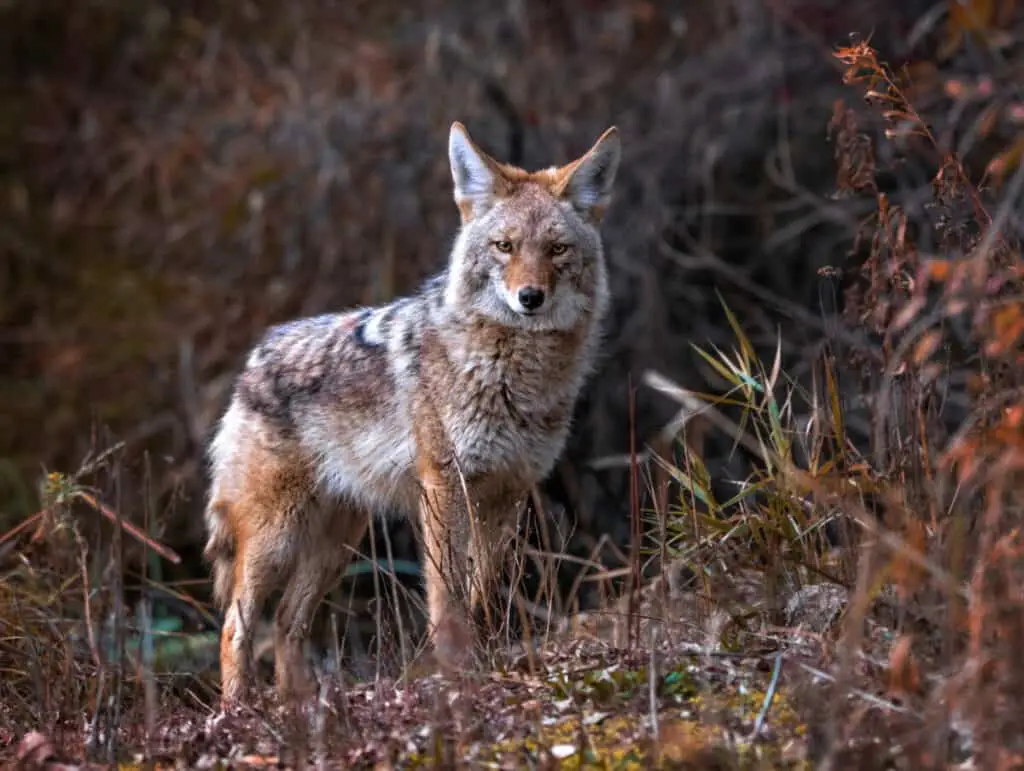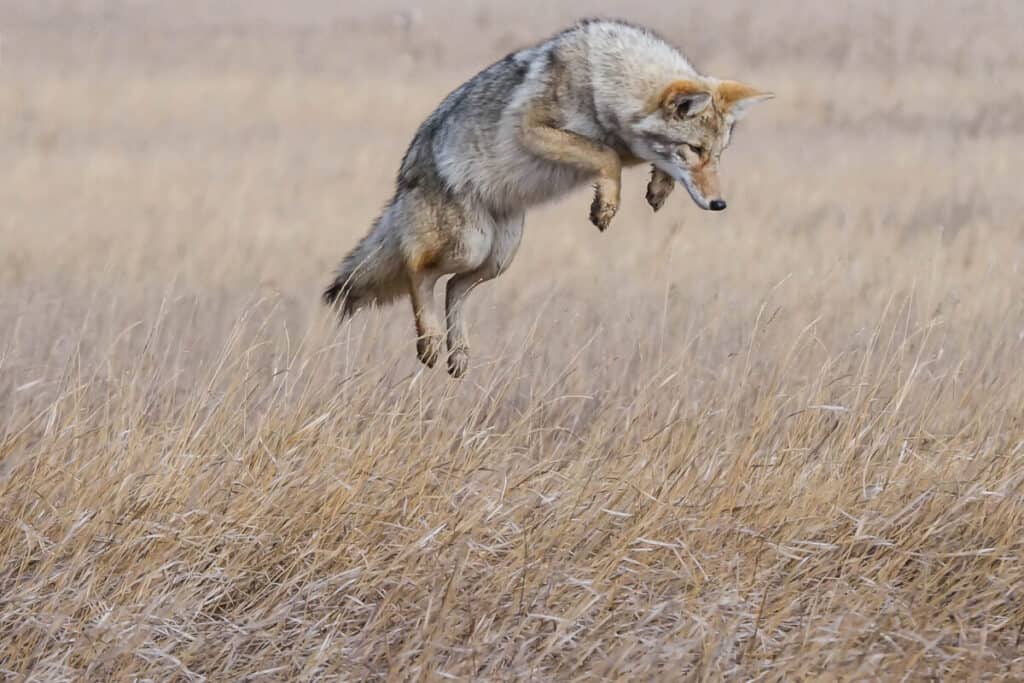Coyote, scientifically known as Canis latrans, is a species of canid native to North America. Coyotes belong to the same family as wolves and dogs but have distinct physical characteristics that set them apart from their relatives. They are highly adaptable animals that can thrive in various habitats ranging from forests and deserts to urban areas.
The coyote’s range extends across much of North America, from Alaska down through Mexico. Their population has increased significantly since European settlement due to habitat destruction, which created more open spaces for hunting and reduced competition with other predators such as wolves.
Despite being hunted by humans for sport or pest control purposes, coyotes continue to persist in many regions thanks to their ability to adapt quickly to changing environments. In this article, we will explore the history and biology of coyotes and examine their behavior, interactions with humans, and roles within ecosystems.

The History Of Coyotes In North America
The coyote is a species of canine that is native to North America. The history of the coyote in this region can be traced back thousands of years, with evidence suggesting their presence as far back as the Pleistocene epoch.
Coyotes have been able to adapt and thrive in a variety of habitats across North America, including deserts, forests, grasslands, and even urban areas.
Coyote migration patterns have played a significant role in shaping their impact on prey populations. As they expanded their range over time, they encountered new species of prey and developed hunting strategies suited to each environment.
In some cases, coyotes have had negative impacts on local ecosystems by preying heavily on certain species or causing declines in population sizes. However, they also play important roles as predators and scavengers in many ecosystems and are valued for their contributions to maintaining biodiversity.
Coyotes’ Predators Revealed: Unveiling the Threats
The Biology And Physical Characteristics Of Coyotes
The history of coyotes in North America is a fascinating subject that sheds light on the evolution and adaptation of the species. However, understanding their biology and physical characteristics is equally important to gain insights into these intelligent animals’ lifestyles.
Coyotes are medium-sized canids with a slender build, pointed ears, narrow snouts, and bushy tails. They have excellent senses of smell, hearing, and vision that help them hunt prey effectively. Coyotes are opportunistic predators that primarily feed on small mammals such as rodents, rabbits, squirrels, and birds. Their hunting habits vary depending on the prey they target; for example, they use pouncing techniques to catch small animals like mice or chase larger prey down over long distances.
In addition to their impressive hunting skills, coyotes are highly vocal animals that use a wide range of calls for communication purposes such as warning others about potential danger or signaling mating readiness. Understanding how these social animals communicate is crucial for studying their behavior patterns and ecological roles in ecosystems.
Three interesting facts about coyotes:
- Coyotes have been known to form strong family bonds and work together to raise offspring.
- Despite being hunted by humans for centuries, coyote populations continue to thrive due to their incredible adaptability.
- Coyote packs can travel up to 30 miles per day while searching for food and shelter.
The Sensory Skills of Coyotes: How Good Are Their Senses?
Coyote Behavior And Social Structure
Like many wild canids, coyotes exhibit complex social behavior and a structured dominance hierarchy within their packs. This hierarchy is established through aggressive displays such as growling, barking, and physical confrontations. Dominant individuals typically have priority access to food resources and mating opportunities.
Coyotes also rely heavily on communication methods such as vocalizations and body language to establish boundaries and maintain the cohesion of their pack. They use howls, yips, barks, whines, and growls to convey different information about potential dangers or territorial claims.
Additionally, they communicate through scent marking by urinating on objects or leaving feces in prominent locations. Overall, these behaviors allow coyote packs to coordinate hunting efforts and effectively defend against threats from other animals.
Coyotes And Humans: Interactions And Conflicts
Coyotes, once considered a predominantly rural species, have been expanding their range into urban areas. With this expansion comes an increase in interactions and conflicts with humans. However, it is important to note that coyote attacks on humans are rare; the majority of these animals prefer to avoid human contact altogether.
In fact, many cities have implemented successful strategies for promoting coexistence between humans and coyotes. Effective urban coyote management involves educating residents about how to reduce potential food sources (such as securing garbage cans) and modifying behavior when encountering coyotes (such as making noise or walking away slowly).
Additionally, non-lethal hazing techniques—like using loud noises or bright lights—are often used to deter coyotes from specific areas where they may be posing a threat to pets or people. By implementing these strategies, communities can minimize negative interactions while allowing for the continued presence of this important predator in our ecosystems.

Ecological Importance Of Coyotes
Coyotes are considered keystone predators, meaning that they have a significant impact on their environment. As top-level carnivores, they help regulate populations of prey species and can even influence vegetation growth by controlling herbivore numbers.
Additionally, coyote denning behaviors create important habitats for other animals such as insects and rodents. Coyotes also exhibit selective predation patterns when it comes to their choice of prey. They tend to target smaller mammals like rabbits and rodents, but will also take down larger prey if necessary.
However, their presence alone can cause changes in behavior among potential prey species, leading to indirect effects on the whole ecosystem. Overall, coyotes serve an important ecological function and should be regarded with respect rather than fear or hostility.
- Ecological Importance of Coyotes:
- Keystone predator
- Regulate prey populations
- Control herbivore numbers through predation
- Important habitat creators
- Denning behaviors provide homes for other animals
- Selective predation
- Smaller mammals targeted
- Larger prey taken if needed
- Serve as scavengers to clean up carrion and prevent disease spread.
Conservation Efforts For Coyotes
Habitat protection is a vital aspect of conservation efforts for coyotes. The expansion of urban areas and agricultural lands has resulted in the fragmentation of natural habitats, leading to significant declines in coyote populations. As such, habitat restoration programs are crucial in protecting coyotes and their ecosystems.
These programs involve preserving or restoring native vegetation, providing corridors between fragmented habitats, and managing invasive species that compete with coyotes for resources.
Another essential component of conservation efforts for coyotes is understanding predator-prey relationships. Coyotes play critical roles as top predators in their respective food webs, regulating prey populations’ size and distribution. Therefore, the loss or reduction of coyote populations can have cascading effects on other species within their ecosystem.
Furthermore, human activities such as hunting and trapping can disrupt these relationships by altering population dynamics artificially. Hence, effective management practices should consider predator-prey interactions when designing policies or interventions aimed at conserving coyote populations.
Conclusion
The coyote, a symbol of resilience and adaptability, has been an important part of North American ecosystems for centuries. With their ability to thrive in diverse habitats and survive on various food sources, these canids have managed to carve out a niche for themselves in the wild.
Despite being misunderstood and often unfairly demonized by humans, coyotes play a crucial role in maintaining ecological balance. As scavengers, predators, and seed dispersers, they help keep prey populations in check and aid in plant growth.
However, human interference through habitat destruction and hunting has threatened their survival. In many ways, the plight of the coyote mirrors that of other wildlife species struggling to coexist with humans.
It is up to us as stewards of the environment to recognize their value and take steps towards conservation efforts aimed at protecting these remarkable creatures so that they may continue to roam our landscapes with freedom and vitality. The coyote teaches us about tenacity amidst adversity; let us learn from them and strive towards creating a world where all beings are respected and valued.

